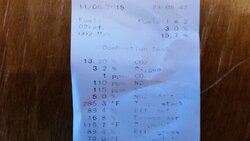For the first time i had a company clean out my oil burner who does not deliver my oil.
He told me that 2 of the settings where way off. One was the pressure of the oil injecting into the burner. It was set at 100 when it should have been 140 PSI. He tells me it is significant and the 140 is on the label on the Beckett Burner. The other setting was at 200 degrees when it should have been at 185. It was a dial like wheel with various degrees found in the little blue box (aquastat?)
I have noticed 2 things already. The furnace is not running as long and as often and that the heat coming from the registers is a lot warmer. I have kept a record of my use and the degree days etc. for 6 years. I have looked it over and noticed that i have used between 25 and 30% more since my oil guy did the annual clean out. I'll have to wait until spring to get an accurate sense of just how much of an improvement the correct settings make.
Would the wrong settings make that much of a difference ?ks than
He told me that 2 of the settings where way off. One was the pressure of the oil injecting into the burner. It was set at 100 when it should have been 140 PSI. He tells me it is significant and the 140 is on the label on the Beckett Burner. The other setting was at 200 degrees when it should have been at 185. It was a dial like wheel with various degrees found in the little blue box (aquastat?)
I have noticed 2 things already. The furnace is not running as long and as often and that the heat coming from the registers is a lot warmer. I have kept a record of my use and the degree days etc. for 6 years. I have looked it over and noticed that i have used between 25 and 30% more since my oil guy did the annual clean out. I'll have to wait until spring to get an accurate sense of just how much of an improvement the correct settings make.
Would the wrong settings make that much of a difference ?ks than




